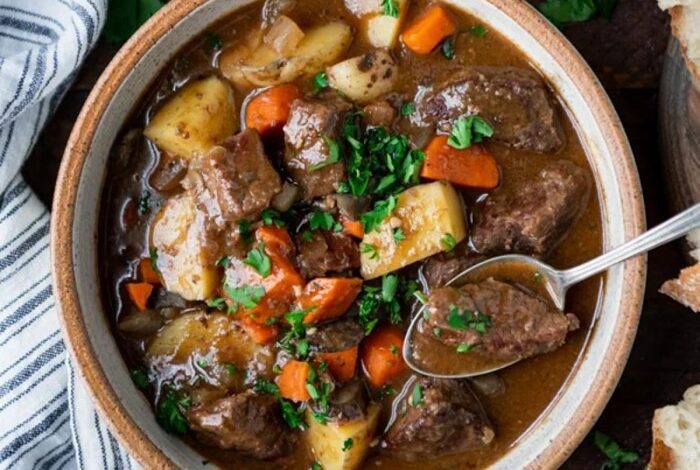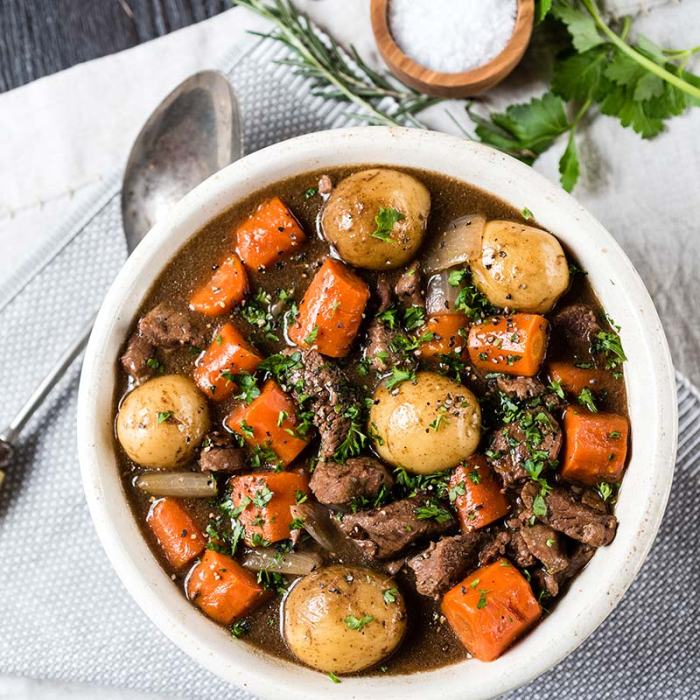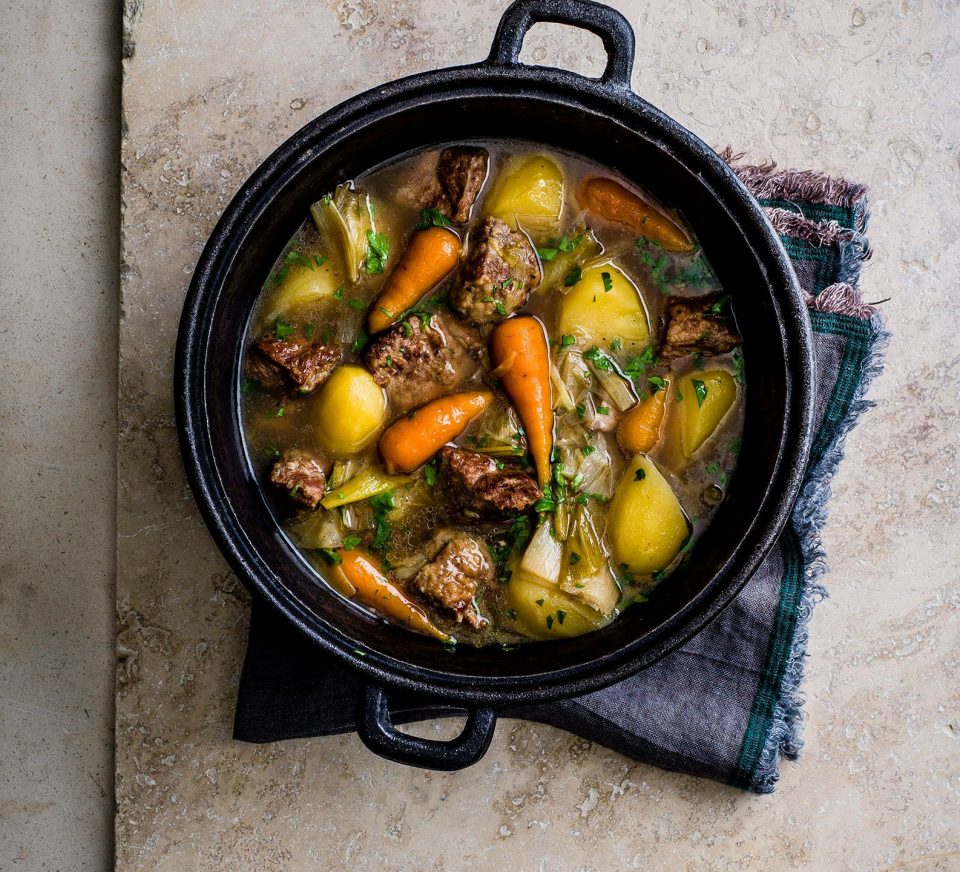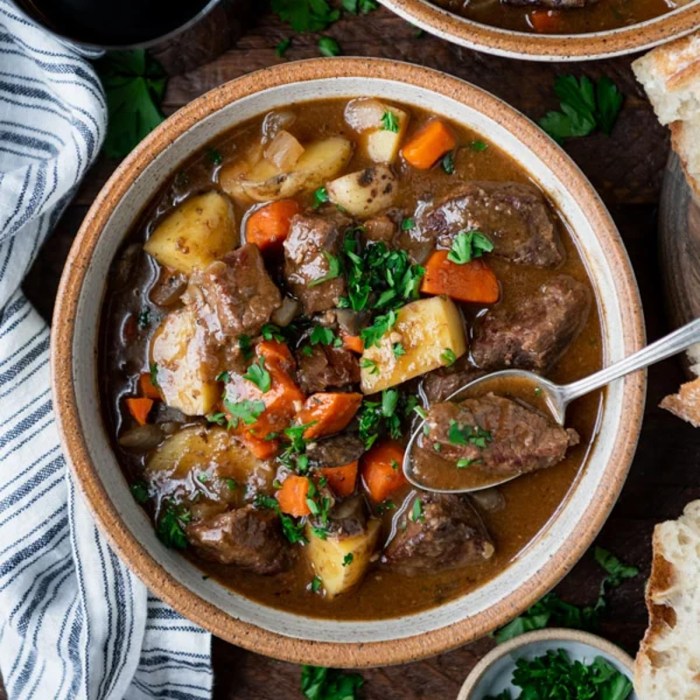
Simple Slow Cooker Irish Stew: A Comforting Classic
Simple Slow Cooker Irish Stew is a comforting classic that brings warmth and flavor to any table. This dish is a testament to the magic of slow cooking, where time and patience transform humble ingredients into a symphony of textures and tastes.
Irish stew has a rich history, rooted in the traditions of Ireland, where it has been a staple for centuries. Its simplicity and adaptability have made it a beloved dish worldwide, with variations emerging from different regions and culinary influences.
The beauty of slow cooker Irish stew lies in its ease of preparation. Simply toss your ingredients into the slow cooker, set it, and forget it! While the stew simmers, the flavors meld and deepen, creating a hearty and satisfying meal.
The slow cooker allows the meat to become incredibly tender, the vegetables to soften to perfection, and the broth to infuse with the essence of the ingredients. This method results in a dish that is both delicious and effortlessly prepared, making it an ideal choice for busy weeknights or casual gatherings.
Simple Slow Cooker Irish Stew
There’s something incredibly comforting about a hearty slow cooker Irish stew. The rich flavors of lamb, vegetables, and Guinness meld together over hours, creating a dish that’s as satisfying as it is delicious. But beyond its taste, slow cooker Irish stew offers a convenient and fuss-free way to enjoy this classic Irish comfort food.
Let’s dive into the history and traditions of this beloved dish.
History of Irish Stew
Irish stew has a long and rich history, dating back centuries. While its exact origins are debated, it’s widely believed to have emerged from the need to use readily available ingredients in a simple and economical way. Irish farmers often raised sheep, providing a plentiful source of lamb, while potatoes, onions, and root vegetables were readily grown in the local climate.
The addition of barley or oats was a common practice, contributing to the stew’s hearty texture. In the early days, the stew was cooked over an open fire in a large pot, often in a cast iron cauldron.
This slow cooking method allowed the flavors to meld and develop, resulting in a tender and flavorful dish. The use of a slow cooker today echoes this traditional approach, allowing the stew to simmer gently for hours, achieving the same depth of flavor.
Benefits of Slow Cooking Irish Stew
Slow cooking is a fantastic method for preparing Irish stew, and it offers numerous advantages over traditional stovetop cooking. The slow cooker’s gentle heat and long cooking time allow the flavors to meld and the meat to become incredibly tender, resulting in a truly satisfying and flavorful dish.
Flavor Development and Texture Enhancement
Slow cooking enhances the flavors of Irish stew in several ways. The long cooking time allows the ingredients to release their natural juices and aromas, creating a rich and complex broth. The slow, gentle heat also breaks down the tough connective tissues in the meat, making it incredibly tender and succulent.
This process also results in a stew with a thicker, more flavorful gravy.
Recipe Variations and Adaptations

The beauty of Irish stew lies in its adaptability. You can easily customize the recipe to your taste and preferences, incorporating different ingredients and techniques. Here are some common variations and substitutions to consider:
Variations in Ingredients
Variations in ingredients offer a way to personalize your Irish stew. You can add a variety of vegetables, meats, and seasonings to create a unique flavor profile.
- Vegetables: While potatoes, carrots, and onions are staples, you can add other vegetables like parsnips, turnips, leeks, celery, or even mushrooms for additional flavor and texture.
- Meats: Traditionally, lamb is used, but you can substitute with beef, mutton, or even a combination of meats. For a vegetarian version, use hearty vegetables like lentils or chickpeas instead of meat.
- Seasonings: While salt and pepper are essential, you can enhance the flavor with herbs like thyme, rosemary, parsley, or bay leaves. A touch of paprika or cayenne pepper can add a subtle kick.
Substitutions for Traditional Ingredients
There are several substitutes for traditional ingredients in Irish stew, allowing you to adapt the recipe based on availability or dietary needs.
- Beef Stock: If you don’t have beef stock, you can use chicken stock or vegetable broth. However, for a more authentic flavor, try using a combination of beef stock and water.
- Guinness: For a richer flavor, Guinness is often added to Irish stew. If you don’t have Guinness, you can substitute with another dark stout beer or even red wine. However, the flavor will be slightly different.
- Flour: Traditionally, flour is used to thicken the stew. If you want to avoid using flour, you can thicken the stew with cornstarch or a slurry of water and cornstarch.
Serving Suggestions
Irish stew can be served in various ways, depending on your preference.
- Traditional: Serve the stew hot in bowls with crusty bread on the side for dipping.
- With Dumplings: Add dumplings to the stew for a heartier meal. These can be made from mashed potatoes, bread crumbs, or even pastry dough.
- Over Rice or Mashed Potatoes: For a more filling meal, serve the stew over rice or mashed potatoes.
- As a Filling: Use the stew as a filling for pastries, such as pot pies or hand pies.
Simple Slow Cooker Irish Stew Recipe
This recipe is a simple and delicious way to make Irish stew in your slow cooker. It’s perfect for a cozy night in, and it’s easy enough for even the busiest of cooks to make.
Ingredients
The ingredients for this recipe are simple and readily available at most grocery stores.
Simple slow cooker Irish stew is a classic comfort food that’s perfect for a chilly evening. The slow cooker does all the work, so you can just toss in the ingredients and let it simmer until tender. For a fresh and flavorful side dish, I like to serve it with a warm zucchini basil salad.
The bright flavors of the salad complement the hearty stew perfectly, creating a balanced and satisfying meal.
- 1 tablespoon olive oil
- 1 pound boneless, cubed beef
- 1 large onion, chopped
- 2 carrots, chopped
- 2 celery stalks, chopped
- 4 cloves garlic, minced
- 1 teaspoon dried thyme
- 1 teaspoon dried rosemary
- 1/2 teaspoon salt
- 1/4 teaspoon black pepper
- 2 cups beef broth
- 1 (14.5 ounce) can diced tomatoes, undrained
- 1 (10 ounce) package frozen peas
- 1/2 cup chopped fresh parsley
Instructions, Simple slow cooker irish stew
These instructions will guide you through the steps of making this simple slow cooker Irish stew.
Simple slow cooker Irish stew is a classic comfort food, but sometimes you crave something a little more exotic. For a taste of the Middle East, try Persian saffron braised chicken thighs , where the saffron’s delicate floral notes and the chicken’s tender texture create a truly memorable meal.
Then, when you’re ready for another comforting bowl, return to your slow cooker for a hearty Irish stew, a dish that’s always a welcome sight on a chilly evening.
- In a large skillet over medium heat, heat the olive oil. Add the beef and cook until browned on all sides.
- Transfer the beef to the slow cooker. Add the onion, carrots, celery, garlic, thyme, rosemary, salt, and pepper to the slow cooker.
- Pour the beef broth and diced tomatoes over the beef and vegetables. Stir to combine.
- Cover and cook on low heat for 6-8 hours, or on high heat for 3-4 hours, until the beef is tender.
- About 30 minutes before serving, stir in the peas.
- Serve hot, garnished with parsley.
Serving Suggestions and Accompaniments

A hearty and comforting dish, Irish stew is a perfect meal for a chilly evening. But what truly elevates this classic is the choice of accompaniments. Whether you prefer traditional pairings or explore new combinations, there’s a perfect match for your slow cooker Irish stew.
Sometimes, the simplest meals are the most satisfying. A slow cooker Irish stew is a perfect example – just chuck in some lamb, potatoes, carrots, and onions, let it simmer all day, and you’ve got a hearty, comforting meal.
But when you’re looking for something a little lighter and more vibrant, gnocchi with chicken pesto and fresh mozzarella is a fantastic choice. It’s a quick and easy dish that’s bursting with flavor, and the fresh mozzarella adds a touch of creamy indulgence.
Of course, nothing beats the warmth and comfort of a slow cooker Irish stew on a chilly evening, but sometimes, you just need a taste of something new and exciting.
Side Dishes
Choosing the right side dish can enhance the flavors and textures of your Irish stew. Here are some suggestions, ranging from classic to contemporary:
| Traditional | Modern | Starchy | Fresh |
|---|---|---|---|
| Mashed Potatoes | Roasted Root Vegetables | Brown Bread | Green Salad |
| Colcannon (Mashed Potatoes with Cabbage) | Polenta | Boiled Potatoes | Mixed Greens with Vinaigrette |
| Soda Bread | Couscous | Rice Pilaf | Tomato and Cucumber Salad |
Beverages
Pairing the right drink with your Irish stew can complete the dining experience. Here are some suggestions:
- Irish Stout:The rich, roasted flavors of stout complement the hearty stew perfectly.
- Red Wine:A full-bodied red wine like Cabernet Sauvignon or Merlot can enhance the savory notes of the stew.
- Apple Cider:A sweet and tart cider adds a refreshing contrast to the richness of the stew.
- Hot Tea:A warm cup of black tea or Irish breakfast tea is a comforting and classic accompaniment.
Tips for Success and Troubleshooting

Making a perfect Irish stew is all about finding the right balance of flavors and textures. Here are some tips to help you achieve the best results and troubleshoot any issues that may arise.
Achieving the Perfect Consistency
The ideal Irish stew should have a rich, flavorful broth and tender, melt-in-your-mouth meat. The vegetables should be cooked through but still have some bite. To achieve this, you can follow these tips:
- Use a good quality cut of meat: Opt for a cut of beef that is known for its tenderness, such as chuck roast or brisket. These cuts have a good amount of marbling, which will contribute to the flavor and richness of the stew.
- Brown the meat before adding it to the slow cooker: This step helps to develop a deeper flavor and create a richer broth. Browning the meat also helps to prevent it from becoming tough and dry.
- Add a little flour to the meat before browning: This helps to thicken the broth and create a more velvety texture. You can also use a tablespoon or two of cornstarch to achieve the same effect.
- Cook the stew on low heat for a longer period of time: This allows the meat to become incredibly tender and the flavors to meld together. The longer cooking time also helps to thicken the broth naturally.
Preventing the Stew from Becoming Too Watery
One common issue with slow cooker Irish stew is that it can become too watery. Here are some strategies to prevent this:
- Don’t overcrowd the slow cooker: If you add too much meat and vegetables, they will release excess moisture and make the stew watery. Leave some space in the slow cooker for the ingredients to cook evenly.
- Use a good quality stock: A flavorful stock will not only enhance the taste of the stew but also help to thicken the broth. Avoid using overly salty or overly watery stock.
- Thicken the broth with cornstarch or flour: If the stew is too watery after cooking, you can thicken it with a slurry of cornstarch or flour. To make a slurry, simply whisk together 1 tablespoon of cornstarch or flour with 2 tablespoons of cold water. Stir the slurry into the stew and simmer for a few minutes until thickened.
Troubleshooting Common Issues
Here are some solutions for common problems you may encounter while making slow cooker Irish stew:
- Meat is tough: If the meat is tough, it may not have been cooked long enough. Continue cooking the stew on low heat for another hour or two until the meat is tender. You can also use a meat tenderizer to help break down the tough fibers in the meat.
- Stew is too salty: If the stew is too salty, you can add a little more stock or water to dilute the saltiness. You can also add a tablespoon or two of sugar to balance out the saltiness.
- Stew is bland: If the stew is bland, you can add more seasonings, such as salt, pepper, garlic powder, or onion powder. You can also add a tablespoon or two of Worcestershire sauce to enhance the flavor.
Irish Stew History and Cultural Significance
Irish stew, a humble yet hearty dish, has a rich history intertwined with Irish culture and tradition. Its origins can be traced back centuries, evolving alongside the lives and culinary practices of the Irish people.
Origins and Evolution
Irish stew’s origins are shrouded in the mists of time, but its roots are firmly planted in the agricultural traditions of Ireland. The dish’s simplicity and use of readily available ingredients made it a staple for generations of Irish families.
The core ingredients – meat, potatoes, and vegetables – were readily available and affordable, ensuring the dish’s accessibility to all social classes. The exact origins of Irish stew are difficult to pinpoint, but historians and food experts believe it emerged as a practical and nourishing meal for farmers and laborers, who often relied on local produce and livestock.
Early versions of the stew likely included whatever vegetables were in season and a variety of meats, depending on availability.
Cultural Significance in Ireland
Irish stew holds a special place in Irish culture, symbolizing warmth, comfort, and togetherness. It’s a dish that evokes memories of family gatherings, cozy evenings by the fire, and the simple pleasures of life. The stew’s popularity transcends regional boundaries and socioeconomic divides, uniting Irish people across generations.
In rural areas, Irish stew remains a traditional Sunday dinner staple, a testament to its enduring appeal. The dish’s significance is also reflected in its representation in Irish literature, folklore, and music, where it often features as a symbol of Irish identity and heritage.
Anecdotes and Stories
Irish stew has been the subject of numerous anecdotes and stories, reflecting its cultural significance and the dish’s enduring appeal. One popular anecdote involves a traveler who, upon arriving in Ireland, was served a steaming bowl of Irish stew.
After taking a bite, the traveler exclaimed, “This is the best stew I’ve ever had!” The Irishman who served the stew replied, “Well, sure, it’s the only stew we have.” This story humorously highlights the simplicity and unpretentious nature of Irish stew, emphasizing its value as a satisfying and comforting meal.
Another story tells of a group of Irish friends who, after a long day of work, gathered around a fire to enjoy a pot of Irish stew. As they shared stories and laughter, they realized that the stew had brought them together, fostering a sense of camaraderie and shared experience.
These anecdotes underscore the dish’s ability to bring people together, creating memories and strengthening bonds.






